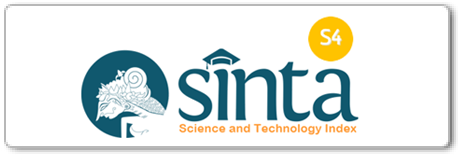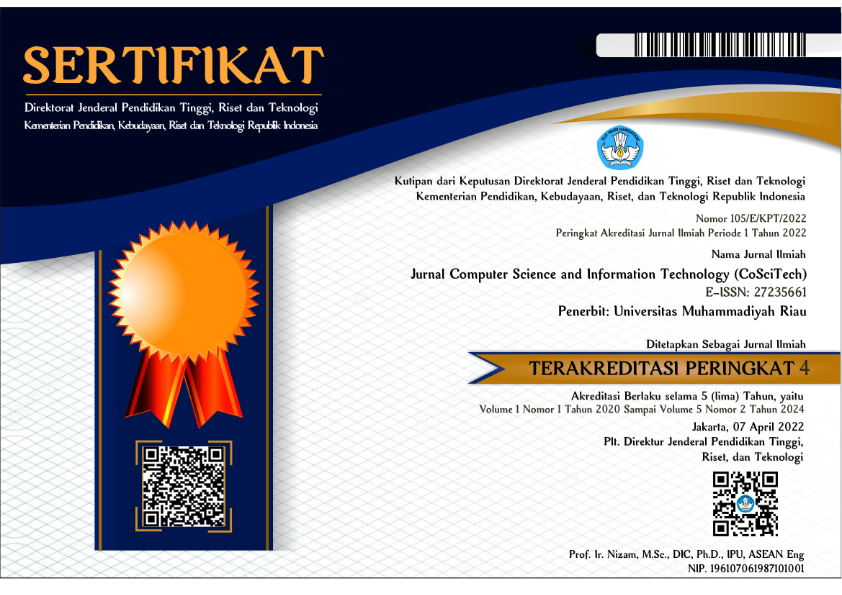The Implementation of Artificial Neural Networks to measure the correlation of teacher's workload to the number of own learning media
DOI:
 https://doi.org/10.37859/coscitech.v4i1.4757
https://doi.org/10.37859/coscitech.v4i1.4757
Abstract
The use of learning media in the teaching and learning process is an effort to increase the effectiveness and quality of the learning process. However, the need for learning media is not compatible with the number of learning media made by the teacher himself. One of the factors that causes it is the teacher's workload which is quite a lot so that the teacher does not have enough time to make his own learning media. This study aims to measure the extent of the correlation between the teacher's workload and the amount of instructional media that the teacher himself made. Artificial Neural Network with Backpropagation method is a tool that can be used to solve complex problems, one of which is to measure the level of correlation. The ability of an Artificial Neural Network with the Backpropagation method to adapt to changes that occur in the input and output values makes the prediction accuracy quite high. The teacher's workload variables used are the number of face-to-face hours of even and odd semesters, additional assignments (deputy principal/head of laboratory), homeroom teacher, and extracurricular coaches. The target used is the number of learning media made by the teacher himself. The data used in this study were taken from the workload of teachers at SMAN 4 Payakumbuh in 2022. The architectural patterns used are 5-4-1, 5-5-1, 5-7-1, 5-10-1, and 5- 12-1. From the test results with the Matlab R2013a software, the best pattern was obtained, namely the 5-12-1 pattern with an MSE value of 0.1001, a MAPE of 2.11, and a data accuracy of 97.89%. From the results of the training and testing, it was concluded that the correlation between the teacher's workload and the amount of self-made learning media is very low or not closely related.
Downloads
References
[2] Undang-Undang. (2017). Undang-Undang Republik Indonesia Nomor 14 Tahun 2017 Revisi Tahun 2005 Tentang Guru Dan Dosen.
[3] Peraturan Pemerintah. (2017). Peraturan Pemerintah Republik Indonesia Nomor 19 Tahun 2017 Tentang Perubahan Atas Peraturan Pemerintah Nomor 74 Tahun 2oo8 Tentang Guru.
[4] Direktorat Jendral Peningkatan Mutu Pendidik Dan Tenaga Kependidikan. (2008). Pedoman Penghitungan Beban Kerja Guru. Departemen Pendidikan Nasional Direktorat Jenderal Peningkatan Mutu Pendidik Dan Tenaga Kependidikan.
[5] A. S. M. Waruwu, N. Rati, D. Buulolo, F. Laia, T. B. Zalukhu, C. F. Bety. (2022). Pentingnya Pendidikan Karakter Anak Di Zaman Serba Digital. Jurnal Kewarganegaraan. Vol. 6 No. 2 September 2022. P-ISSN: 1978-0184 E-ISSN: 2723-2328. https://doi.org/10.31316/jk.v6i2.3057
[6] P. Alkhairi, I. S. Damanik, A. P. Windarto. (2019). “Penerapan Jaringan Saraf Tiruan untuk Mengukur Korelasi Beban Kerja Dosen Terhadap Peningkatan Jumlah Publikasi”. Prosiding Seminar Nasional Riset Information Science (SENARIS). 2019. DOI: 10.30645/senaris.v1i0.65
[7] M. Hendriani, Rais, and L. Handayani. (2019). “Penerapan Artificial Neural Network Terhadap Identifikasi Wajah Menggunakan Metode Backpropagation”. Nat. Sci. J. Sci. Technol.. Vol. 8, no. 3, pp. 203–208. 2019. doi: 10.22487/25411969.2019.v8.i3.14599
[8] Sapriyah. (2019). “Media Pembelajaran Dalam Proses Belajar Mengajar”. Prosiding Seminar Nasional Pendidikan FKIP Universitas Sultan Ageng Tirtayasa. Vol. 2, No.1, hal. 470 – 477. 2019. p-ISSN 2620-9047, e-ISSN 2620-9071.
[9] A. Hatma, La Mido, Nety. (2020). “The Correlation Between Teachers’ Professionalism And Students Learning Achievement At Smp Negeri 2 Wabula”. https://www.ejournal.lppmunidayan.ac. id/index.php/english. 2020. E-ISSN: 2686-3731 P-ISSN: 2460-0504
[10] L. Sinaga, E. Irawan, W. Saputra, I. S. Damanik, I. S. Saragih. (2020). “Penerapan Jaringan Saraf Tiruan Metode Backpropogation Dalam Memprediksi Distribusi Air Pada PDAM Tirtauli Kota Pematangsiantar“. Vol. 2, pp. 161-168. 2020. Prosiding Seminar Nasional Riset Dan Information Science (SENARIS). ISSN: 2686-0260.
[11] M. Windarti, I. Sulistyowati. (2019). “Korelasi Nilai UN, IP Tahun Pertama Terhadap Masa Studi Dengan Backpropagation Correlation of Final Examination, GPA for Study Period With Backpropagation”. SISFOTENIKA. Vol 9(2), hal. 115. 2019. DOI:10.30700/jst.v9i2.430.
[12] Muhtarom, Nizaruddin, A. E. P. Nugraha. (2020). Pelatihan Pembuatan Media Untuk Pembelajaran Jarak Jauh. Jurnal Abdimas Bina Bangsa. Vol. 01, No. 01, Juli, 2020. Hal 98-106. DOI: 10.46306/jabb.v1i1.19.
[13] Angreini, D., Muhiddin, M., & Nurlina, N. (2020). Pengaruh Penggunaan Media Audio Visual Terhadap Motivasi dan Hasil Belajar IPA Siswa Kelas V SD Negeri Bontoramba. Edumaspul: Jurnal Pendidikan, 4(1), 42-49. https://doi.org/10.33487/edumaspul.v4i1.199
[14] F. Chan, M. Sofwan, E. D. Saragih. (2020). Kemampuan Guru dalam Menggunakan Media Pembelajaran Berbasis Teknologi Informasi dan Komunikasi di Sekolah Dasar. Jurnal Edumaspul. Vol. 4, No. 1, year 2020, page 208-2018. https://doi.org/10.33487/edumaspul.v4i1.343
[15] Saragih, E. (2020). Kemampuan Guru dalam Menggunakan Media Pembelajaran Berbasis Teknologi Informasi dan Komunikasi di Sekolah Dasar. Edumaspul: Jurnal Pendidikan, 4(1), 208-2018. https://doi.org/10.33487/edumaspul.v4i1.343
[16] R. Winda, F. Dafit. (2021). Analisis Kesulitan Guru dalam Penggunaan Media Pembelajaran Online di Sekolah Dasar. Jurnal Pedagogi dan Pembelajaran. Volume 4, Number 2, September 2021, pp. 211-221. DOI:10.23887/jp2.v4i2.38941
[17] H. U. Sari, A. P. Windarto, I. S. Damanik. (2022). Analisis Jaringan Saraf Tiruan dengan Backpropagation pada Korelasi Matakuliah Pratikum Terhadap Tugas Akhir. http://ejurnal.stmik-budidarma.ac.id/index.php/jurikom. Hal 115 - 121. 2022. DOI 10.30865/jurikom.v9i1.3835
[18] F. Zakaria, S. A. Che Kar, R. Abdullah, S. I. Ismail, N. I. Md Enzai. (2021). A Study on Correlation of Subjects on Electrical Engineering Course Using Artificial Neural Network (ANN). Jurnal Pendidikan Universitas Asia (AJUE). Volume 17, Nomor 2, April 2021. https://doi.org/10.24191/ajue.v17i2.13391
[19] H. Dai. (2022). Teaching Reform of Ancient Literature Based on Credible BP Neural Network Technology in New Media Environment. Hindawi Security and Communication Networks. Volume 2022, Article ID 1507338, 11 pages. https://doi.org/10.1155/2022/1507338.
[20] D. V. Hutabarat, Solikhun, M. Fauzan, A. P. Windarto, F. Rizki. (2021). “Penerapan Algoritma Backpropagation dalam Memprediksi Hasil Panen Tanaman Sayuran”. BIOS : Jurnal Teknologi Informasi dan Rekayasa Komputer. Vol. 2, No. 1, hlm. 21-29. 2021. ISSN: 2722-0850, doi: https://doi.org/10.37148/bios.v2i1.18.
[21] A. I. Ramadhan, J. T. Hardinata, Yuegilion Pranavarna Purba. (2021). “ Analisa Jaringan Saraf Tiruan Backpropagation Untuk Memprediksi Prestasi Siswa SMA Muhammadiyah Serbelawan”, BRAHMANA: Jurnal Penerapan Kecerdasan Buatan Vol. 3, No. 1, Desember (2021), pp. 18-26, ISSN: 2715-9906.
[22] Salmiati,Y. Yunus, Sumijan. (2021). Tingkat Pemahaman Siswa dalam Pembelajaran Daring dan Tatap Muka Langsung dalam Masa Pandemi Covid-19. Jurnal Sistim Informasi dan Teknologi Vol. 3 No. 3 (2021) 95-101. DOI: 10.37034/jsisfotek.v3i3.50.
[23] N. Yeni, Y. Yunus. (2021). “Tingkat Korelasi Prestasi Akademik Terhadap Siswa SMP Menggunakan Metode Backpropagation”. Jurnal Sistim Informasi dan Teknologi. Vol. 3, No. 3, Hal: 108-113. 2021. https://jsisfotek.org/index.php. DOI: 10.37034/jsisfotek.v3i3.52.
[24] C. Liu. (2022). “Risk Prediction of Digital Transformation of Manufacturing Supply Chain Based on Principal Component Analysis and Backpropagation Artificial Neural Network”. Alexandria Engineering Journal. Vol 61, Hal 775–784. 2022. https://doi.org/10.1016/j.aej.2021.06.010
[25] D. Marlina, F. Arifin. (2021). “Predicting The Number of Tourists Based on Backpropagation Algorithm”. RESTI journal (System Engineering and Information Technology). Vol. 5 No. 3, hal 439 – 445. 2021. http://jurnal.iaii.or.id. ISSN Electronic Media: 2580-0760. DOI: https://doi.org/10.29207/resti.v5i3.3061
[26] A. Rikki, D. E. R. Purba, M. L. Siahaan, P. L. Marpaung, R. M. Manalu. (2022). Artificial Neural Networks in Predicting the Number of New Students using the Backprobapication Method (Case Study: Santo Thomas Catholic University Medan). Jurnal Mantik. vol. 6, no. 2, pp. 2091-2097, Aug. 2022. http://www.iocscience.org/ejournal/index.php/mantik/index. DOI:https://doi.org/10.35335/mantik.v6i2.2762.
[27] M. Thoriq. (2022). Peramalan Jumlah Permintaan Produksi Menggunakan Jaringan Saraf Tiruan Algoritma Backpropagation. Jurnal Informasi dan Teknologi Vol . 4 No. 1 (2022) 27-32. doi: 10.37034/jidt.v4i1.178
[28] Hayadi, B., Sudipa, I., & Windarto, A. (2021). Model Peramalan Artificial Neural Network pada Peserta KB Aktif Jalur Pemerintahan menggunakan Artificial Neural Network Back-Propagation. MATRIK : Jurnal Manajemen, Teknik Informatika Dan Rekayasa Komputer, 21(1), 11-20. https://doi.org/https://doi.org/10.30812/matrik.v21i1.1273
[29] Indrayati Sijabat, P., Yuhandri, Y., Widi Nurcahyo, G., & Sindar, A. (2020). Algoritma Backpropagation Prediksi Harga Komoditi terhadap Karakteristik Konsumen Produk Kopi Lokal Nasional . Digital Zone: Jurnal Teknologi Informasi Dan Komunikasi, 11(1), 96-107. https://doi.org/10.31849/digitalzone.v11i1.3880
[30] D. Finaliamartha, D. Supriyadi, G. F. Fitriana. (2022). Penerapan Metode Jaringan Syaraf Tiruan Backpropagation Untuk Prediksi Tingkat Kemiskinan Di Provinsi Jawa Tengah. Jurnal Teknologi Informasi dan Ilmu Komputer (JTIIK), Vol. 9, No. 4, Agustus 2022, hlm. 751-760.DOI: 10.25126/jtiik.202294806














